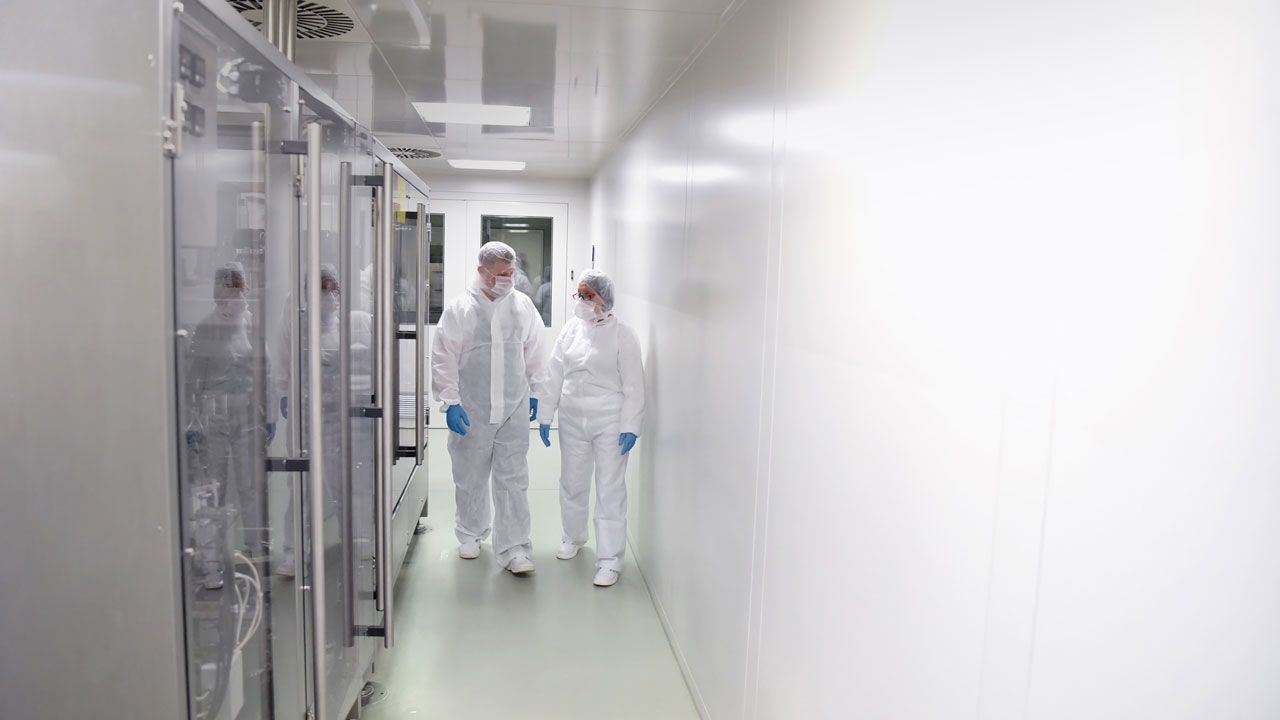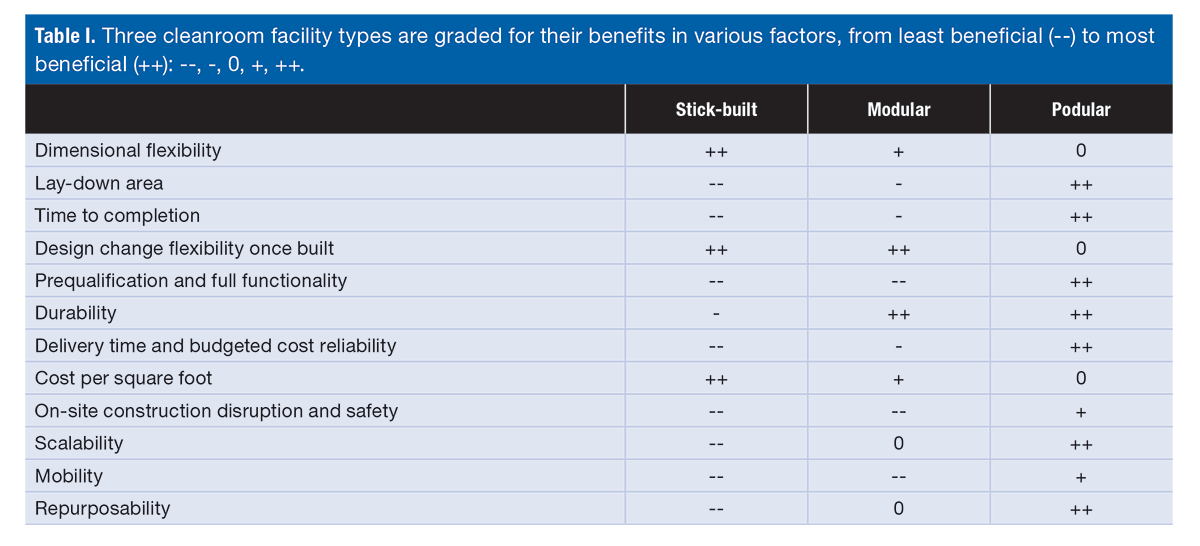News
Article
Pharmaceutical Technology
Choosing a Cleanroom Infrastructure Technology
Author(s):
Consider a matrix of factors when choosing what type of cleanroom facility to construct.
industrieblick - stock.adobe.com

The bio/pharmaceutical industry is experiencing a paradigm shift—not only for therapies, but for the entire support infrastructure. The process streams and surrounding cleanroom and facility infrastructures for recombinant proteins are drastically different from those for small-molecule processes. Advances in cell and gene therapies and continuous bioprocessing require a shift as well. In these cases, the scale of the processes can range from small, per-patient batches to multiple, 2000-L fluid volume streams. These different applications require in-depth review so that that the best processing and cleanroom infrastructure platform may be chosen. Decisions can no longer be based on a single parameter, such as initial cost. Rather, a matrix of different factors must be evaluated. This article addresses the different decision points behind this approach, to guide determination of the best cleanroom and technology choice.
Facility infrastructures
The traditional brick-and-mortar facility is still the main type used in the industry. These constructions are typically very capital intensive, requiring lengthy design and construction phases. A project completion timeframe of two to three years is not uncommon for these types of buildings.
Shell building infrastructures with box-in-box cleanrooms are another option. Such buildings are typically high-span buildings, similar to warehouses. The benefit of this type of infrastructure is that it permits faster construction and more flexible use of space. With this approach, the entire space does not need to be planned out in detail at the outset of a construction project. Instead, cleanroom and other infrastructures can be integrated gradually.
The container-based approach has shell and internal infrastructure designed off site while prefabricated, container-based units are stacked on each other and interconnected to form an entire facility. This type of facility requires significant upfront design, and design is fairly inflexible. Because these facilities, to a large degree, are built off-site, they take less time to build. However, they can be relatively inflexible since these facilities are typically designed for a specific application.
Cleanroom infrastructures
Except for off-site, container-based buildings, the other two facility types require the integration of cleanrooms and auxiliary infrastructure. Three types of cleanroom infrastructures can be used: stick-built, modular wall panels, and off-site prefabricated units (podular). These types of infrastructure can be used in a singular solution or as part of a hybrid solution that includes some or all of these approaches.
In stick-built construction, the wall material is typically gypsum or sheetrock, which is either epoxy or PVC coated. The framing and wall installation are constructed on-site, very similar to the way drywall is handled in the construction of homes. Stick-built construction is the most widely used within the pharmaceutical industry but has begun to fall out of favor due quality concerns and lack of long-term durability. Further, the construction requires a large lay-down area for supplies and a significant number of workers on site for framing construction and finish work. Such construction sites also experience high particulate load, as particles are shed when materials of construction are cut and installed.
Modular wall panels are typically honeycomb aluminum panels, which are coated with a multitude of different materials, most commonly unplasticized polyvinyl chloride (uPVC). The panels are prefabricated off-site, shipped, and installed on-site, once the framing is complete. Again, a lay-down area is required to order to supply the essential materials to the installation team. Installation is faster and cleaner than it is with stick-built systems, because the panels are precut and ready to install. Furthermore, the wall panels are robust, because the aluminum sheet underneath the uPVC coating retains structural integrity.
Off-site prefabricated units are cleanroom or auxiliary infrastructures that are fully built off-site as three-dimensional structures. These units typically have an aluminum or steel framing and use epoxy-coated walls or modular wall panels. Depending on the design and requirements, the podular units can be fully outfitted, including heating, ventilation, and air conditioning; fire suppression; and automation, and the units undergo factory acceptance testing (FAT) before leaving the manufacturing site.
Once the units get to the site, they are introduced into the building and interconnected to provide a fully functional cleanroom infrastructure. There is no lay-down area requirement because all the materials have already been assembled. Because the shell building construction or refurbishment occur in parallel with the building of the podular structure, the time-to-run is much faster than it is with more traditional approaches.
A matrix as guidance
There is never a one-size-fits-all solution. Typically, it is necessary to review a multitude of factors in deciding which cleanroom solution will work best for a particular project. The application and existing building infrastructure are important. Other questions to ask include the following:
- What are the long-term and short-term plans in regard to clinical processing space and final commercial site?
- Will capacity need to be scaled up or down in the future?
- How soon will the cleanroom infrastructure be needed?
- Is the depreciation length of the site a relevant factor in the decision?
Often the first question results in a focus on cost, specifically cost per square foot. However, this is a very limited view and fails to consider other cost factors as well as the actual needs of the process and long-term plan of the site (1, 2). For example, the speed and reliability of the delivery of the infrastructure can have a greater implication than cost per square foot, creating the opportunity to delay the capital investment and de-risking the investment. Instead of looking at one cost factor, the total cost of ownership analysis should guide decisions because it is more comprehensive and representative.
The matrix in Table I, while not all-inclusive, lists many of the factors that should be considered yet are sometimes overlooked. Each factor is described in the following sections.
Table I. Three cleanroom facility types are graded for their benefits in various factors. Click to enlarge.

Dimensional flexibility. When a site is refurbished, the building’s dimensional arrangement may be restrictive to some of the cleanroom types. The most flexible type is stick-built, because it is cut and installed at the site and can be used in any way needed. Since modular wall panels are prefabricated off-site, their dimensional flexibility can be restricted. The three-dimensional, podular prefabricated cleanroom infrastructure has dimensional requirements and is the least flexible of these three types.
Lay-down area. The lay-down area, which is the area required to store construction materials, can be substantial, up to the same size as the cleanroom infrastructure constructed. Either the building must have space to utilize as a lay-down area or an off-site temporary storage must be used. Material logistics and security are also important. With large projects, the impact of supply and transfer of materials should also be considered during the planning phase.
Time-to-completion. The time-to-completion should be reviewed for the total facility and separately for the cleanroom infrastructure within the facility. In both cases, prefabricated, off-site units can be up to 50% faster due to parallel building of the facility, utilities, cleanroom, and auxiliary infrastructure and equipment. Even when an existing facility is refurbished, off-site units have the benefit of being built in the time the facility is refurbished. Furthermore, the productivity level in off-site construction is up to 30% higher, since there are no weather, permitting, or logistics delays and no head count density restrictions. Off-site builds can also use predesigned superstructures with standard designs that are built to stock and supplied even faster.
Design change flexibility. If a design change is required after the cleanroom infrastructure has been built, the stick-built and modular wall panel-built structures are easier to change than the podular design, if only wall structures are changed. The detailed design phase should be performed with all potential possibilities and needs in mind. However, new construction reports (3) show that turnkey facility designs, which can be chosen without going through lengthy and costly design phases, are increasingly used. Standardization may ultimately bring down timelines and costs.
Prequalification and full functionality. Traditional cleanroom infrastructures are designed and built by acquiring and constructing components, which means a large bill of material list is required to produce a fully functional cleanroom. Any flaws must be corrected on site, which can take time. Off-site podular units are built and assembled within the manufacturing area of the supplier and typically undergo an FAT to ensure that the cleanroom is fully functional as specified when it reaches the install site.
Durability. The cleaning processes and single-use pallet tanks used within cleanroom infrastructures require cleanroom durability. If the wall surface is damaged and the material underneath the wall surface is hygroscopic, the processing areas may be contaminated by mold or other foreign matter. Honeycomb uPVC wall panel material or epoxy-coated aluminum wall structures are more robust than epoxy or PVC-coated gypsum walls. The stick-built construction option requires frequent refurbishment and maintenance to avoid problems caused by damage resulting from a single incident or cumulatively, over a long-term cleaning regime.
Delivery time and budgeted cost reliability. Many on-site construction projects overrun the given timeline and cost. In off-site prefabrication, the workforce’s size can be more easily adjusted, making the budgeting and construction timeline process much more reliable.
Cost per square foot. When considering only the cost per square foot, inexpensive materials often win the race. However, this is a short-sighted approach. Instead, the balance between material expense and quality must be considered. Questions to consider include the following:
- Does the cleanroom infrastructure and material meet the quality requirements of the application?
- How durable is the specific material, and will it require frequent refurbishment?
- What is included in the cost per square foot and how reliable is it?
On-site construction disruption and safety. The stick-built construction material and type generates the most onsite work, followed by modular wall panels and then off-site prefabrication. Any work that must take place on-site can disrupt project progress of existing processes. A high density of workers and heavy onsite traffic demands that safety be closely considered and well managed.
Scalability. Uninterrupted scalability is important, especially with newer biological therapies, such as cell therapies. Capacity expansions that require changes in the existing infrastructure or construction in the vicinity of the existing space will detract from scalability. However, a cleanroom infrastructure with its own air-handling system supports scalability.
Mobility. The ease with which cleanroom infrastructure can be moved to another location may not be a requirement initially. However, in many cases, it will prove to be beneficial. For example, in some cases, the end-user will not know whether the existing building will be used for the entire product life cycle, either because the property is leased or has not been appropriately sized for expansion. However, a prefabricated cleanroom can be moved to another location.
Repurposability. Historically, repurposing traditional cleanroom infrastructures has been restricted to cases in which a different end-user has acquired the site and using it for the same or a similar application. In this case, the site and processing spaces need to be thoroughly decontaminated, including the potentially elaborate mezzanine level.
It is more difficult to repurpose stick-built options. However, podular options can be and have been repurposed. Repurposing reduces risk for companies that do not reach regulatory milestones or that no longer need the cleanroom infrastructure, which can then be reused, providing some recovery of initial investments.
Conclusion
The matrix presented in this article reviews some of the performance indicators that should be considered in determining which cleanroom infrastructure is best suited for one’s application. A hybrid approach that combines two or more of the infrastructures is also an option. The key in each case is to consider the need for speed and predictability of outcome. With predictability, reliable and flexible capacity planning can be possible.
References
- M.W. Jornitz, Pharmaceutical Technology, Bioprocessing and Sterile Manufacturing Supplement, pp. 12-18 (May 2015)
- M.W. Jornitz, P. Makowenskyj, and S. Backstrom, Am. Pharma. Rev. 20 (6) 2017.
- McKinsey & Company, “The Next Normal in Construction. How Disruption is Reshaping the World’s Largest Ecosystem,” mckinsey.com (June 2020).
About the Author
Maik Jornitz is CEO, G-CON Manufacturing, Inc.
Article Details
Pharmaceutical Technology
Volume 45, No. 1
January 2021
Pages: 36–39
Citation
When referring to this article, please cite it as M. Jornitz, “Choosing a Cleanroom Infrastructure Technology," Pharmaceutical Technology, 45 (1) 2021.
Newsletter
Get the essential updates shaping the future of pharma manufacturing and compliance—subscribe today to Pharmaceutical Technology and never miss a breakthrough.






